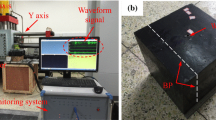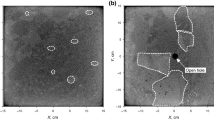Abstract
Multistage fracturing of the horizontal well is recognized as the main stimulation technology for shale gas development. The hydraulic fracture geometry and stimulated reservoir volume (SRV) is interpreted by using the microseismic mapping technology. In this paper, we used a computerized tomography (CT) scanning technique to reveal the fracture geometry created in natural bedding-developed shale (cubic block of 30 cm × 30 cm × 30 cm) by laboratory fracturing. Experimental results show that partially opened bedding planes are helpful in increasing fracture complexity in shale. However, they tend to dominate fracture patterns for vertical stress difference Δσ v ≤ 6 MPa, which decreases the vertical fracture number, resulting in the minimum SRV. A uniformly distributed complex fracture network requires the induced hydraulic fractures that can connect the pre-existing fractures as well as pulverize the continuum rock mass. In typical shale with a narrow (<0.05 mm) and closed natural fracture system, it is likely to create complex fracture for horizontal stress difference Δσ h ≤ 6 MPa and simple transverse fracture for Δσ h ≥ 9 MPa. However, high naturally fractured shale with a wide open natural fracture system (>0.1 mm) does not agree with the rule that low Δσ h is favorable for uniformly creating a complex fracture network in zone. In such case, a moderate Δσ h from 3 to 6 MPa is favorable for both the growth of new hydraulic fractures and the activation of a natural fracture system. Shale bedding, natural fracture, and geostress are objective formation conditions that we cannot change; we can only maximize the fracture complexity by controlling the engineering design for fluid viscosity, flow rate, and well completion type. Variable flow rate fracturing with low-viscosity slickwater fluid of 2.5 mPa s was proved to be an effective treatment to improve the connectivity of induced hydraulic fracture with pre-existing fractures. Moreover, the simultaneous fracturing can effectively reduce the stress difference and increase the fracture number, making it possible to generate a large-scale complex fracture network, even for high Δσ h from 6 MPa to 12 MPa.














Similar content being viewed by others
References
Ahmed MG, Qi Q, Russell M, Scott N, Ted R (2014) New insights into hydraulic fracturing of shale formations. In: International petroleum technology conference. doi:10.2523/17594-MS
Anderson GD (1981) The effects of mechanical and frictional rock properties on hydraulic fracture growth near unbonded interfaces. In: SPE annual technical conference and exhibition, Society of Petroleum Engineers
Beugelsdijk LJL, de Pater CJ, Sato K (2000) Experimental hydraulic fracture propagation in a multi-fractured medium. In: SPE Asia Pacific conference on integrated modeling for asset management, Society of Petroleum Engineers
Blanton TL (1982) An experimental study of interaction between hydraulically induced and pre-existing fracturing. In: SPE/DOE unconventional gas recovery symposium, Society of Petroleum Engineers
Blanton TL (1986) Propagation of hydraulically and dynamically induced fractures in naturally fractured reservoirs. In: SPE/DOE unconventional gas technology symposium, Society of Petroleum Engineers
Branagan PT, Peterson RE, Warpinski NR, Wright TB (1996) Characterization of a remotely intersected set of hydraulic fractures: results of intersection well no. 1-B, GRI/DOE multi-site project. In: SPE annual technical conference and exhibition, Society of Petroleum Engineers
Bunger A (2005) Near-surface hydraulic fracture. Ph.D. dissertation, University of Minnesota, Minneapolis
Casas L, Miskimins JL, Black A, Green S (2006) Laboratory hydraulic fracturing test on a rock with artificial discontinuities. In: SPE annual technical conference and exhibition, Society of Petroleum Engineers
Chen LH, Chen WC, Chen YC, Benyamin L, Li AJ (2014) Investigation of hydraulic fracture propagation using a post-peak control system coupled with acoustic emission. Rock Mech Rock Eng. doi:10.1007/s00603-014-0620-y
Cipolla CL, Lolon EP, Dzubin B (2009) Evaluating stimulation effectiveness in unconventional gas reservoirs. In: SPE annual technical meeting, Society of Petroleum Engineers
Daneshy AA (2003) Off-Balance Growth: a new concept in hydraulic fracturing. J Petrol Technol 55(4):78–85. doi:10.2118/80992-MS
de Pater CJ, Beugelsdijk LJL (2005) Experiments and numerical simulation of hydraulic fracturing in naturally fractured rock. In: 40th US symposium on rock mechanics, American Rock Society Association
de Pater CJ, Cleary MP, Quinn TS, Barr DT, Johnson DE, Leen W (1994) Experimental verification of dimensional analysis for hydraulic fracturing. SPE Prod Facil 9(4):230–238. doi:10.2118/24994-PA
de Pater CJ, Groenenboom J, van Dam DB, Romijn R (2001) Active seismic monitoring of hydraulic fractures in laboratory experiments. Int J Rock Mech Mining Sci 38(6):777–785. doi:10.1016/S1365-1609(01)00042-9
Detournay E (2004) Propagation regimes of fluid-driven fractures in impermeable rocks. Int J Geomech 4(1):35–45. doi:10.1061/(ASCE)1532-3641(2004)4:1(35)
Fallahzadeh SH, Rasouli V, Sarmadivaleh M (2014) An investigation of hydraulic fracturing initiation and near-wellbore propagation from perforated boreholes in tight formations. Rock Mech Rock Eng. doi:10.1007/s00603-014-0595-8
Gale JFW (2008) Natural fractures in shales and their importance for gas production. In: Tectonics Studies Group annual meeting
Gale JFW, Reed RM, Holder J (2007) Natural fractures in the Barnett shale and their importance for hydraulic fracture treatments. AAPG Bulletin 91(4):603–622
George W, Barry D, Robert D (2009) Simultaneous hydraulic fracturing of adjacent horizontal wells in the Woodford Shale. In: SPE hydraulic fracturing technology conference, Society of Petroleum Engineers
Roberto SR, Larry B, Green, S, Jeff B, Eric E, Aniket S (2013) Defining three regions of hydraulic fracture connectivity, in unconventional reservoirs, help designing completions with improved long-term productivity. In: SPE annual technical conference and exhibition, Society of Petroleum Engineers
Gu H, Weng X (2010) Criterion for fractures crossing frictional interfaces at non-orthogonal angles. In: 44th US rock mechanics symposium and 5th US–Canada rock mechanics symposium, American Rock Mechanics Association
Gu HR, Weng XW, Lund JB, Mack GM, Ganguly U, Suarez-Rivera R (2011) Hydraulic fracture crossing natural fracture at non orthogonal angles, a criterion, its validation and applications. In: SPE hydraulic fracturing technology conference, Society of Petroleum Engineers
Hossain MM, Rahman MK, Rahman SS (2000) Hydraulic fracture initiation and propagation: roles of wellbore trajectory, perforation and stress regimes. J Pet Sci Eng 27:129–149
Jeffrey RG, Bunger AP, Lecampion B, Zhang X, Chen ZR, Allison DP, de Beer W, Dudley JW, Siebrits E, Thiercelin M, Mainguy M (2009) Measuring hydraulic fracture growth in naturally fractured rock. In: SPE annual technical conference and exhibition, Society of Petroleum Engineers
King GE (2010) Thirty years of gas shale fracturing: what have we learned? In: SPE annual technical conference and exhibition, Society of Petroleum Engineers
King GE, Haile L, Jim S, Dobkins TA (2008) Increasing fracture path complexity and controlling downward fracture growth in the Barnett shale. In: SPE gas production conference, Society of Petroleum Engineers
Liu ZY, Chen M, Zhang GQ (2014) Analysis of the influence of a natural fracture network on hydraulic fracture propagation in carbonate formations. Rock Mech Rock Eng 47:575–587. doi:10.1007/s00603-013-0414-7
Mayerhofer MJ, Lolon EP, Warpinski NR, Cipolla CL, Walser D, Rightmire CM (2010) What is stimulated reservoir volume? SPE Prod Oper 25(1):89–98. doi:10.2118/119890-PA
Olsen TN, Bratton TR, Thiercelin MJ (2009) Quantifying proppant transport for complex fractures in unconventional formations. In: SPE hydraulic fracturing technology conference, Society of Petroleum Engineers
Olson JE, Bahorich B, Holder J (2012) Examining hydraulic fracture—natural fracture interaction in hydrostone block experiments. In: SPE hydraulic fracturing technology conference, Society of Petroleum Engineers
Rafiee M, Soliman MY, Pirayesh E (2012) Hydraulic fracturing design and optimization: a modification to zipper frac. In: SPE annual technical conference and exhibition, Society of Petroleum Engineers
Renshaw CE, Pollard DD (1995) An experimentally verified criterion for propagation across unbonded frictional interfaces in brittle, linear elastic materials. Int J Rock Mech Min Sci Geomech 32(3):237–249
Rickman R, Mullen M, Petre E, Grieser B, Kundert D (2008) A practical use of shale petrophysics for stimulation design optimization: all shale plays are not clones of the Barnett shale. In: SPE annual technical conference and exhibition, Society of Petroleum Engineers
Ripudaman M, Mukul MS (2012) Impact of completion design on fracture complexity in horizontal wells. In: SPE annual technical conference and exhibition, Society of Petroleum Engineers
Roussel NP, Sharma MM (2010) Optimizing fracture spacing and sequencing in horizontal well fracturing. In: SPE international symposium and exhibition on formation damage control, Society of Petroleum Engineers
Sarmadivaleh M, Rasouli V (2013) Modified Reinshaw & Pollard criteria for a non-orthogonal cohesive natural interface intersected by an induced fracture. Rock Mech Rock Eng. doi:10.1007/s00603-013-0509-1
Sarmadivaleh M, Rasouli V (2014) Test design and sample preparation procedure for experimental investigation of hydraulic fracturing interaction modes. Rock Mech Rock Eng. doi:10.1007/s00603-013-0543-z
Soliman MY, Hunt JL, El-Raaba AM (1990) Fracturing aspects of horizontal wells. J Pet Tech 42(8):966–973
Teufel LW, Clark JA (1984) Hydraulic fracture propagation in layered rocks: experimental studies of fracture containment. Soc Pet Eng J 24(1):19–32. doi:10.1016/0148-9062(84)91172-0
Warpinski NR, Branagan PT (1989) Altered-stress fracturing. J Pet Tech 41(9):990–991
Warpinski NR, Teufel LW (1987) Influence of geologic discontinuities on hydraulic fracture propagation. J Pet Tech 39(2):209–220. doi:10.1016/0148-9062(87)90223-3
Warpinski NR, Lorenz JC, Branagan PT (1993) Examination of a cored hydraulic fracture in a deep gas well. SPE Prod Facil 8(3):150–158. doi:10.1016/0148-9062(94)92893-2
Yashwanth C, Camilo M, Carl S, Chandra R (2013) An experimental investigation into hydraulic fracture propagation under different applied stresses in tight sands using acoustic emissions. J Pet Sci Eng 108:151–161. doi:10.1016/j.petrol.2013.01.002
YostII AB, Overby Jr WK, Wilkins DA, Locke CD (1988) Hydraulic fracturing of a horizontal well in a naturally fractured reservoir: gas study for multiple fracture design. In: SPE gas technology symposium, Society of Petroleum Engineers
Zhou J, Chen M, Jin Y, Zhang GQ (2008) Analysis of fracture propagation behavior and fracture geometry using a triaxial fracturing system in naturally fractured reservoirs. Int J Rock Mech Min Sci 45(7):1143–1152. doi:10.1016/j.ijrmms.2008.01.001
Acknowledgments
This paper was support by the Major National Science and Technology Projects of China (No. 2012ZX05018-004) and the National Basic Research Program of China (No. 2013CB228004).
Author information
Authors and Affiliations
Corresponding author
Rights and permissions
About this article
Cite this article
Yushi, Z., Shicheng, Z., Tong, Z. et al. Experimental Investigation into Hydraulic Fracture Network Propagation in Gas Shales Using CT Scanning Technology. Rock Mech Rock Eng 49, 33–45 (2016). https://doi.org/10.1007/s00603-015-0720-3
Received:
Accepted:
Published:
Issue Date:
DOI: https://doi.org/10.1007/s00603-015-0720-3




